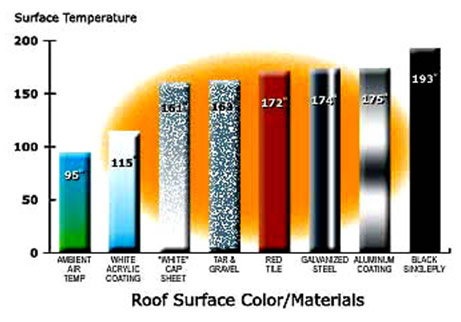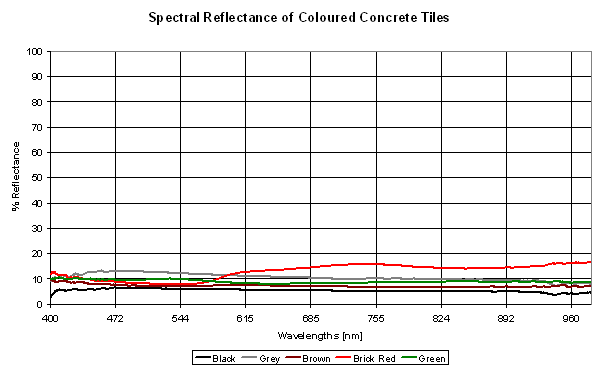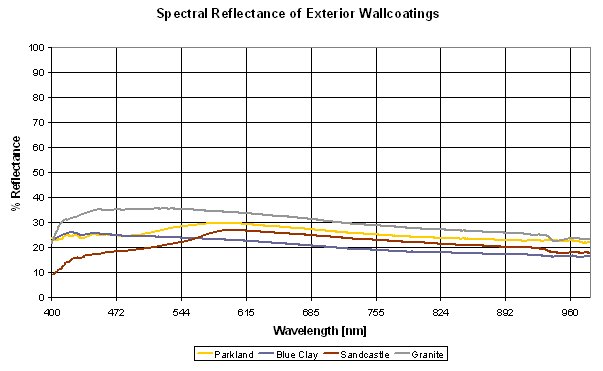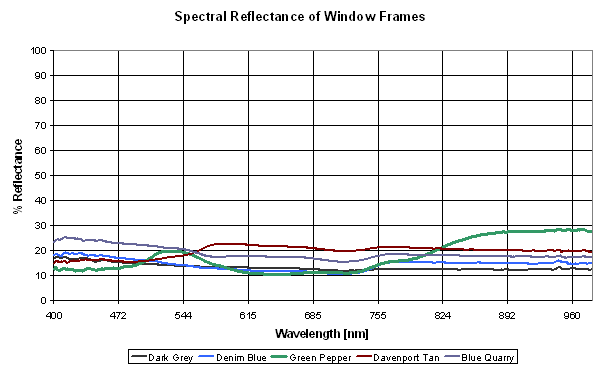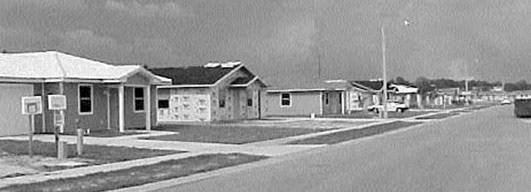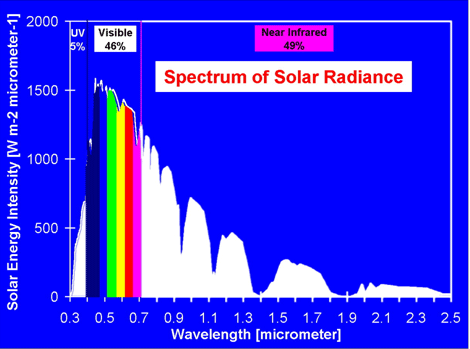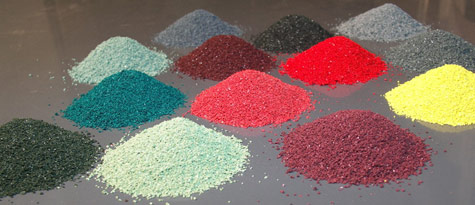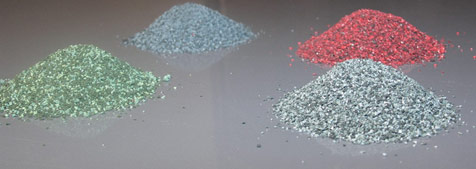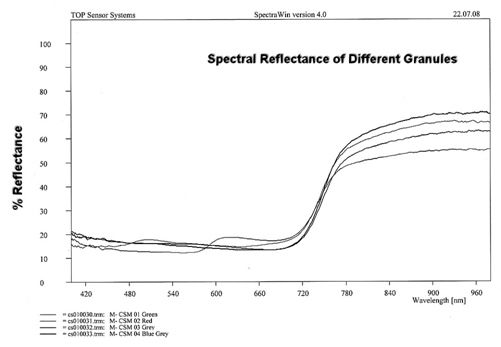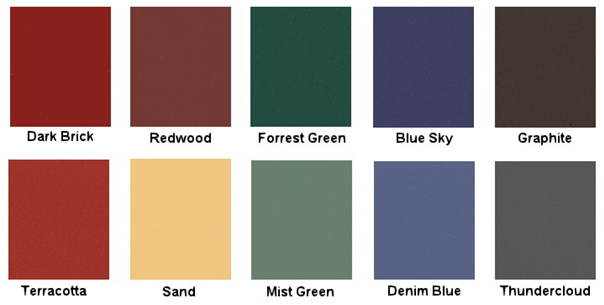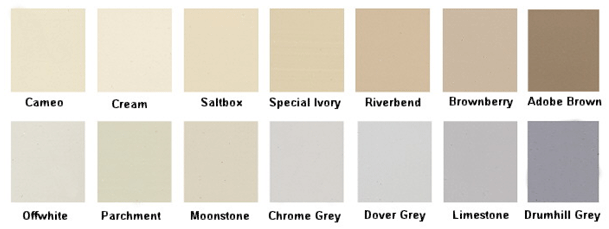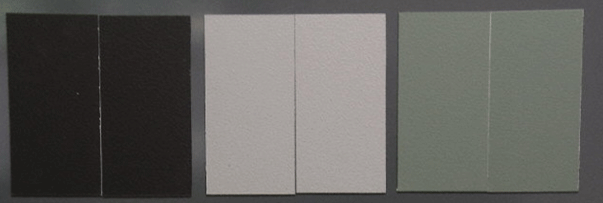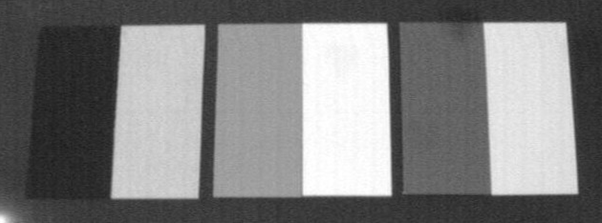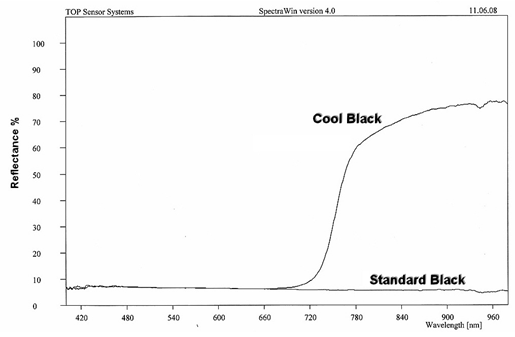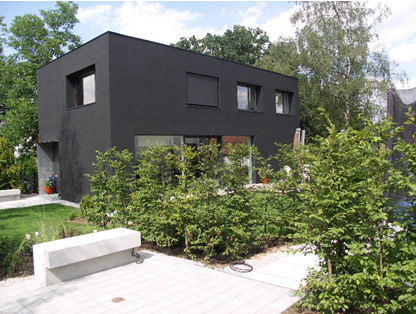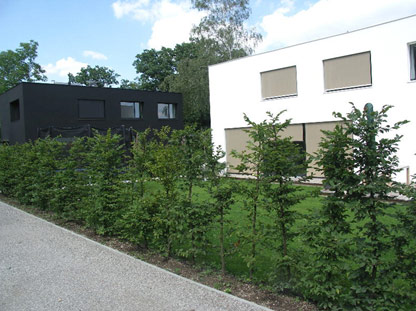Innovative Technologies for Energy Saving and Increase of Thermal Comfort
|
It is commonly known that most of the world wide energy consumption occurs in the so called “sun belt” of the earth. One reason for this is the higher population in these areas and the other reason is the poor efficiency of the air conditionings in use. The energy efficiency of air conditionings ranges from 50% for the bigger units and around 30% for the small single room units. Compared to the efficiency of newer oil or gas heating systems with over 90% it becomes very clear that there is a huge potential in energy savings when the heat from the sun is blocked before it is led into the house. When we take a closer look at the solar reflectance of the exterior surfaces of our homes we can see that it really would make sense to change them to lighter colours so they do not absorb so much heat from the sun.
The above graphic (Source: www.cooltexasbuildings.net) shows the temperatures given in F° of different roof colours heated up by the sun under an ambient air temperature of 95°F. The white coating and the black represent the best and the worst case condition. We can see that more or less all other materials reach the same temperature range. According to EPA, $40 billion is spent annually in the US to air condition buildings – one sixth of all electricity generated in a year! Qualified roof products substantially reduce air conditioning needs thus reducing energy bills. In most of Texas, reducing the heat entering buildings is a prime requirement to reducing cooling costs. This is true for both residential Or own investigations have shown that all of the materials like roof shingles, concrete tiles and paints for the exterior walls of houses exhibit more or less the same poor solar reflectance like the materials shown above. The spectral reflectance of different materials under investigation is shown in the following diagrams. The samples under test have been measured in the wavelength range from 400 to 980 nm (0.4 to .98 micron) which represents the wavelength region where the sun has the most power.
A good example for really absorbing surfaces are roofs with asphalt shingles which are widely used in the United States. Even some of them have very light granules in their textured surface these shingles exhibit a very strong solar absorption. The above diagram shows that all of the evaluated shingles show a spectral reflectance for the wavelength region where the sun has the most power of below 20%. This means a roof where those shingles are applied will absorb more than 80% of sunlight which would be for homes located in the sunbelt of earth at least 720 W/m² which then would be lead to the inside of the house. Depending on how much insulation is between the roof and the rooms of a house this energy has to be compensated by the air conditioning. As the efficiency of typical air conditionings is only 50% or below this means for the case with no insulation 1420 W/m² of electrical power is needed for compensation. Some typically coloured concrete tiles for roofs have been investigated and the results concerning the solar reflection properties are very much the same like as for asphalt shingles. The diagrams on the next page show the spectral reflectance of commonly used concrete tiles in Japan. The solar reflectance of all colours evaluated remains mostly below 15% only the reflectance of the Brick Red coloured concrete tile is slightly higher but still remains under 20% of solar reflectance.
Exterior wall paints are mostly not in dark colours, lighter, pastel colour tones are more common. But even these lighter colours exhibit a higher solar absorption than one would think from the brighter appearance. Although the walls of a house are not as much exposed to the sun like a roof, it makes sense to reduce the solar absorption also on these surfaces to reduce the overall heat gains from the sun.
Due to more esthetical reasons window frames and doors are very often painted in darker fully tinted colours so they look separate from the walls and give a house a structured appearance. As the surface area of window frames is small compared to the roof and the walls the solar heat gains over these areas do not contribute as much to the overall heat gains but there are other reasons to decrease the solar absorption. Vinyl window frames will degrade under the sun much faster than other segments of the house and when they are painted in darker colours the high solar absorption can induce temperatures in the vinyl which come close to the deforming temperature of specifically vinyl. So when darker colours are applied to these surfaces it makes sense to use solar reflective coatings or vinyl foils as well.
With all these negative aspects like solar induced heat gains and degradation of the materials themselves when darker colours are used to paint a house, why not paint a house white. “Cool Roofs” is an often used expression when people refer to white painted roofs and their high potential in energy savings. From the standpoint of energy savings it really makes sense to have a white roof instead of a dark grey or even black roof as most of the heat from the sun is led into the house over the roof. Everybody knows that a dark surface when exposed to sunlight becomes much hotter than a white surface. There is only one problem, people do not except white roofs they prefer the esthetical more appealing darker roofs for their homes. For flat industrial buildings where the roof cannot be seen, white roofs are getting more accepted.
It is hard to imagine when all roofs in a village would have been painted white but it would look somehow monotonous compared to the situation now. But even light, pastel coloured roofs would absorb a huge amount of solar energy so it makes sense to have a close look at the solar spectrum to see if it is possible to be reflective for solar rays and still have nice and appealing colours.
For better orientation the visible part of the solar energy spectrum is coloured in the so called rainbow colours. The white marked region covers the UV and the near infrared wavelengths of solar radiation where our eyes do not see. The near infrared region represents about 50% of the solar energy so there are possibilities to use darker colours but still be solar reflective at other wavelengths. With the right pigments with very specific spectral properties it is possible to produce coatings which allow esthetical appealing colours in the visible but which are highly reflective for the rest of the solar spectrum and so do not absorb as much solar energy as a colour matched standard coating. The new “cool” paints and coatings have been tested according to ASTM 903-96 by independent institutes and generally for darker colour tones the solar reflectance is over 35% higher than the reflectance of colour matched standard paints and for lighter colours 15 to 20% better. The table shows the resulting solar induced energy gains for three different standard and colour matched solar reflective paints with increasing brightness. The energy of the sun was at 900 W/m² which is a typical value for a clear summer day.
Even with the impressive numbers for potential energy savings with the new solar reflective coatings it will be hard to convince people to apply energy saving paints for the exterior when they do not exhibit an esthetical gain for their homes. So the developments of the solar reflective coatings have been done with emphasis on an esthetical appealing look, the maximum of solar reflective performance and outstanding weather fastness with a dirt and rain repelling surface. The colour charts below show a selection of roof coatings which are textured in colour like the commonly used asphalt roof shingles but which exhibit a solar reflection comparable to the cool grey above. these coatings can be applied on older roofs with asphalt shingles to give them a new appealing look and to reduce the solar heat gains over the roof drastically. The coatings consist of a primer to assure best adhesion to the underground and a top coat according to the colour charts.
For asphalt roof shingles stone granules have been coated with the new spectrally selective pigments which guarantee a high solar reflection in the near infrared even on the normally very absorptive asphalt of the shingle. With these granules it is possible to cover the standard substrates used for asphalt shingles and still have a high solar reflection. This method will keep the costs of the shingles down.
This photograph shows a selection of stone granules coated in some basic colours. On the photo below the basic colours have been mixed to get some typical roof colours.
The diagram shows the spectral reflectance from 400 to 980 nm of the mixed granules over a black background like it would be over asphalt. The reflectance in the near infrared at wavelength over 730 nm is significantly higher than the reflectance of standard shingles.
For steel roofs or roofs with concrete tiles which normally are painted in one unique colour some examples for colourful coatings with high solar reflection are shown below. Again for best performance and for good adhesion to the underground a primer coating has to be applied prior to the coloured top coat. For steel roofs an anti corrosive primer is used.
For the walls of a house normally lighter colours in pastel shades are selected. One has to know that even the lighter coloured pastel shades do have high solar absorption. Even they look light their solar absorption is depending on the depths of the colour over 60%. So it makes sense to have the wall coatings solar reflective too. The colour charts below show a selection of solar reflective wall coatings in lighter pastel colour tones.
For a paint company at Shanghai some often used colour tones have been modified with the new spectrally selective pigments. The photograph on the next page shows a selection of colour tones where the difference of solar reflection in the near infrared is significantly high. The photograph shows the standard colour and the colour matched solar reflective colour tone. With a special camera for the near infrared it is possible to show the difference in reflection in the near infrared wavelength range where the sun still has 50% of its energy .
The photograph below has been made with a special camera for the near infrared and one can see that the right paint samples look reflective white.
The spectral reflectance from 400 – 980 nm has been measured with a spectrometer and one can see that the reflectance in the invisible near infrared is almost as high as a white paint. At Greifenberg in Bavaria / Germany an ensemble of five very modern houses has been built and the house owner wanted two of the houses to bee painted in black. This was only possible with a solar reflective black paint according to the above diagram. With a standard black the houses would gain too much heat in the summer with the possibility of degradation of the Styrofoam® insulation.
Summary Dark roofs absorb a tremendous amount of solar radiation and become extremely hot. Hot roof surfaces translate to higher utility and equipment costs and contribute to elevated air temperatures and last not least lead to faster material degradation. Reflective or cool roof and exterior wall applications can reduce air conditioning energy use, and the level of roof insulation required. It has been demonstrated that it is possible to have solar reflective roofs and walls in all appealing colours which are normally used for buildings. Energy bills for cooling a home can be reduced by at least 30%.
|
